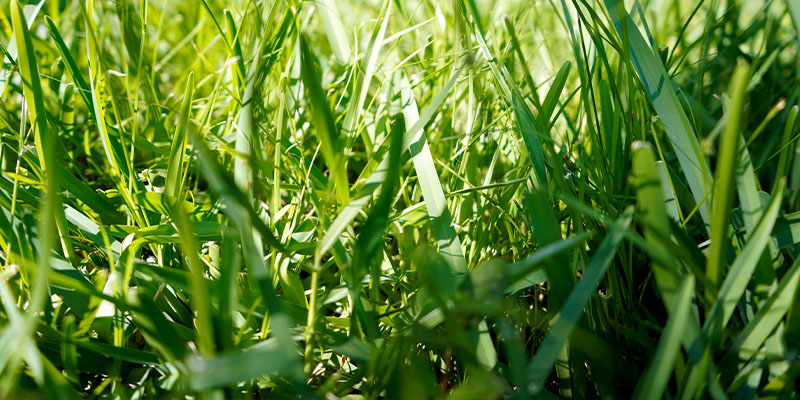St. Augustine grass (Stenotaphrum secundatum) is a warm-season turfgrass that is widely favored by homeowners for its lush, dense growth and excellent tolerance to heat and humidity. With its ability to thrive in a variety of soil conditions and provide a vibrant green lawn, St. Augustine grass is a popular choice.
The Best Ways Homeowners Can Care for St. Augustine Grass
Below, we will take a little time to explore the characteristics of St. Augustine grass, its appeal to homeowners, potential threats to its health, and best practices for care, including mowing and irrigation techniques. So, let’s go ahead and get started on how homeowners can best care for St. Augustine grass.
Why St. Augustine Grass is So Popular with Homeowners
St. Augustine grass is a warm-season grass that is native to the southeastern United States. It is a popular choice for homeowners because it is drought-tolerant, shade-tolerant, and relatively pest-resistant. St. Augustine grass is also known for its thick, lush blades, which give it a beautiful, green appearance. There are a few reasons why St. Augustine grass is popular with homeowners:
- Drought-tolerance: St. Augustine grass is drought-tolerant, which means that it can survive in areas with low rainfall. This makes it a good choice for homeowners who live in dry climates or who want to save water.
- Shade-tolerance: St. Augustine grass is shade-tolerant, which means that it can still grow in areas that receive partial or full shade. This makes it a good choice for homeowners who have trees or shrubs in their yard.
- Pest-resistance: St. Augustine grass is relatively pest-resistant, which means that it is less likely to be damaged by insects or diseases. This makes it a low-maintenance grass that is easy to care for.
- Appearance: St. Augustine grass has thick, lush blades that give it a beautiful, green appearance. This makes it a popular choice for homeowners who want a lawn that looks healthy and attractive.
With its deep green beauty, its ability to withstand drought conditions, its ability to healthily grow in shaded spaces, and its resistance to common pests, St. Augustine grass is very popular with homeowners.
Threats to the Health of St. Augustine Grass
While St. Augustine grass is resilient, it is susceptible to certain threats that can affect its health. Yes, it’s true that this species of grass is not only aesthetically pleasing and is able to stand up to a number of negative elements. But, that doesn’t mean that it’s completely invulnerable. In fact, there are a number of things that can hurt St. Augustine grass, including the following:
Chinch Bugs
Chinch bugs are small insects that feed on St. Augustine grass, causing yellowish patches that can spread quickly. Regular monitoring and appropriate pest control measures are essential to prevent damage.
Fungal Diseases
St. Augustine grass can be susceptible to fungal diseases such as brown patches or gray leaf spots. Proper lawn care practices, including proper watering and avoiding excessive thatch buildup, can help minimize the risk of disease.
Improper Mowing
Mowing too low or using dull blades can stress St. Augustine grass and make it more susceptible to diseases and weed infestations.
Waterlogging
St. Augustine grass is not tolerant of waterlogging. If the soil is too wet, the roots of the grass can rot, which can lead to the grass dying.
Characteristics of St. Augustine Grass
St. Augustine grass is known for its dense, carpet-like growth, vibrant green color, and coarse texture. It forms a thick, matted turf that effectively crowds out most weeds. This warm-season grass variety thrives in regions with mild winters and hot summers, such as the southern United States and coastal areas.
Mowing and Irrigation Tips for St. Augustine Grass
Proper mowing and irrigation practices are crucial for maintaining the health and appearance of St. Augustine grass:
- Mowing height. Set the mower blades to a height of 3 to 4 inches (7.5 to 10 cm) to maintain the vigor of St. Augustine grass. Avoid cutting more than one-third of the grass blade length at a time.
- Regular mowing. Aim to mow the lawn regularly, typically on a weekly or bi-weekly basis during the active growing season. Adjust your mowing frequency based on the grass’s growth rate.
- Sharpen mower nlades. Keep the mower blades sharp to ensure clean cuts. Dull blades can tear the grass, leading to increased stress and susceptibility to diseases.
- Watering practices. St. Augustine grass requires regular watering to thrive. Deeply water the lawn, providing around 1 inch (2.5 cm) of water per week, either through rainfall or irrigation.
- Morning watering. Water early in the morning to allow the grass blades to dry before evening, reducing the risk of fungal diseases.
- Avoid overwatering. Overwatering can lead to shallow root growth and increased vulnerability to pests and diseases. Ensure proper drainage to prevent waterlogged soil conditions.
Also, strive for good water conservation. Consider using irrigation techniques like drip irrigation or smart sprinkler systems that optimize water usage and reduce waste.
What We’ve Learned
St. Augustine grass is a popular turfgrass choice among homeowners due to its ability to thrive in a variety of conditions and its aesthetic appeal. However, maintaining its health requires proper care.
By following best practices such as setting the appropriate mowing height, regular mowing with sharp blades, and implementing efficient irrigation techniques, homeowners can ensure the long-term health and beauty of their St. Augustine grass lawns. Additionally, vigilance against potential threats such as chinch bugs and fungal diseases will help preserve the vitality of this resilient grass species.

